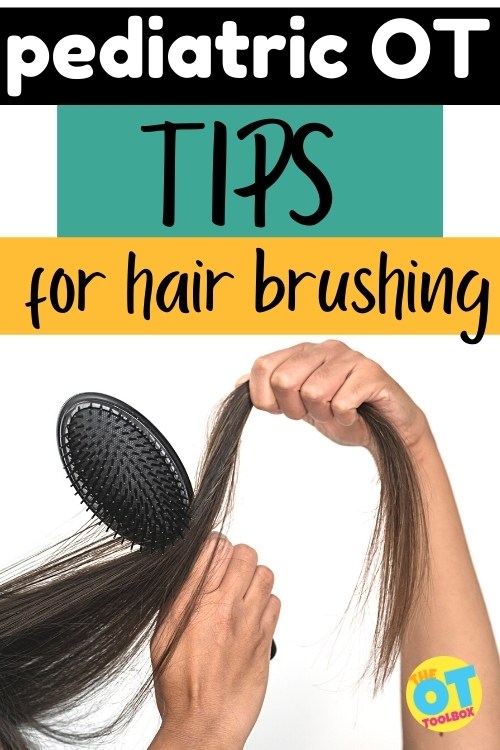For many children, hair brushing is a challenging ADL task due to difficulties with sensory regulation. Using tools such as a sensory brush or a sensory diet can help support sensory issues that impact hair brushing. Individuals with sensory challenges related to their scalp can be further exacerbated by knots, pulling of hair, shampooing, or daily stress when it comes to this hygiene task. Fortunately there are some tips to help sensory needs and hair brushing.
NOTE: The information and strategies in this blog post on sensory hair brushing will not be appropriate for all types of hair and all sensory issues.

Sensory Hair Brushing
Individuals with sensory processing sensitivities may feel that getting their brushed hurts, or may find it overstimulating.
Other children may have challenges with hair brushing as it signals the morning routine is almost complete. They associate hair brushing with having to go to school or daycare, which increases their anxiety. Whatever the reason your child dislikes having their hair brushed, it can be very disruptive to your child’s routine, and anyone else in the home as well.
Sensory Hair Brushing Tips
Check out the tips below to help alleviate stress with hair brushing.
Tip #1: Brush hair while in the tub or sink
When you brush your child’s hair in the tub or sink:
- You can build on the relaxed mood to complete a stressful task
- Warm water temperature offers calming sensory input.
- Having probably just washed your child’s hair, the conditioner/oil (depending on hair type) will help to allow a comb to slip through your child’s hair with ease.
- You will also be able to work out any larger knots they may have with your fingers much easier as the water runs in the direction of hair growth.
- Your child will more than likely be distracted with toys that are in the tub/activity occurring around the sink area, keeping the focus off having their hair brushed.
- Make sure to braid or put it into a top knot if your child’s hair is long, to prevent tangles in the morning.
- Bonus Tip! Don’t have time to wash your child’s hair every night, or don’t take a bath daily? Use a spray bottle to moisten your child’s hair, then brush it out. You can use a detangle to bring an extra element of fun to it too!
When it comes to brushing, the most important thing is to set up a routine, using the hair brushing techniques that work for the child’s hair type. Stick to that routine. Consider using a visual schedule, written schedule, or checklist.
Tip # 2: Turn hair brushing into a Game
Using humor and distraction in the form of a game is another great way to help your child feel less stress and sensory issues during hair brushing. You can have them “earn” points for each stroke or set of strokes, have a countdown, or sing a silly song.
Tip # 3: Use Role Play in Hair Brushing
Children learn best through play! Practice with a doll or let them brush your hair. As you do this, talk about how they are feeling and acting when they are brushing your hair. Are they being gentle? What can they do if they hit a knot?
It will also be helpful if you talk to them about how you’re feeling or how the doll might be feeling while having their hair brushed. Do you feel calm? Is getting your hair brushed hurting you?
Make sure that you emphasize the positives as well! You can use real terms such as sensory issues with hair brushing, and explain what is happening.
Share with your child how good it feels to have your hair brushed, that it makes you feel clean, and that it makes you look ready for the day.
Tip # 4: Let Your Child Do it Themselves
When you give your child control of an activity, you take away fear of the unknown, or in this case, give back control over what you are asking to be done.
This works well for children who say that you’re pulling too hard, their scalp is super sensitive, or they dread having to work out knots. By letting them brush their own hair, they are in charge of the pressure, pace and how they work through knots in their hair.
Your children may also be more willing to participate if they know that they are in control of the situation. Be on standby in case they need help!
If the whole hair brushing process can’t be done by the child, let them participate in some aspect. That might be applying conditioner/oil. It might be that they hand the brush or comb to the person brushing. The main concept here is taking ownership in the task through active participation.
Tip # 5: Use a Wide Tooth Comb
A wide tooth comb will slide through hair much easier, and with less resistance than a traditional brush.
Another perk to a wide tooth comb is that it doesn’t have bristles, which many kids find irritating to their scalp, and often gets caught easily in long hair.
Amazon (affiliate links) has several different types of brushes and combs for sensitive scalps. They also have detangling brushes. Just type “sensitive scalp brush” into the search box.
Or try a comb with wider teeth (affiliate link), depending on the hair type.
Tip # 6: Hold Hair Close to the Scalp
Whether your child has long or short hair, holding hair close to the scalp or placing your other hand on their head can help to limit the amount of tugging they feel during hair brushing.
Limiting the tugging sensation by keeping their head stabilized will also prevent activation of the inner ear, which can be alerting or cause dizziness. If they are particularly sensitive to the tugging sensation, or have poor head/neck control, they may be compensating by letting their head drop back with the slightest of tugs.
This is particularly important for children with long hair, as brushing down the back can elicit the startle reflex.
Tip # 7: Use a Timer
Using a timer is a fail safe tip for working on tolerance of any activity. Set the a timer to see how long your child can tolerate having their hair brushed as a baseline, then add 5 seconds once a week until you are able to thoroughly brush their hair.
A countdown timer (affiliate link) is very effective. You can use the timer on your phone or you can look for a visual timer app to add an extra layer of fun. Many visual apps have surprises at the end or turn colors as the app is counting down.
If you do not want the added input of electronics during this calming time of day, a separate timer (affiliate link) is best.
Tip # 8: Use a Social Story
A social story is a book created about any activity that your child has challenges with. The story talks about what’s going to happen, how it will feel, and the appropriate social responses that your child should have with the activity. Read the story to them right before completing hair brushing to maximize its effect!
Don’t have a social story? Ask your therapist to help you create one. You can also find free social story generators online, or use a premade one.
Bonus Tip! If a social story is too long or advanced for your child, try using a visual schedule! This is a simplified version of the social story and can be adjusted based on your child’s abilities.
Implementing Tips for sensory issues and hair brushing
These tips can help to break any negative behaviors or emotions that may surround your child’s sensory issues with hair brushing, and give you a foundation to start a fresh routine.
Start by trying one recommendation that you think will work for your child, give it a week, and if it’s still not working, try another.
Working through hair brushing challenges takes time, and is a trial-and-error process. Hopefully you will find these tips helpful!
Looking for more resources?
The OT Toolbox has a great resource called The Sensory Resource Handbook for tackling sensory issues related to hair brushing and creating a sensory diet for the many difficulties you are your child may be facing.
One of our new bloggers has a great resource on Amazon called Seeing Your Home and Community with Sensory Eyes (affiliate link). This is a new manual for parents, therapists, and caregivers to understand, accommodate, and treat tricky sensory situations and community settings with real life strategies, tips, and understanding.

Contributor: Kaylee is a pediatric occupational therapist with a bachelors in Health Science from Syracuse University at Utica College, and a Masters in Occupational Therapy from Utica College. Kaylee has been working with children with special needs for 8 years, and practicing occupational therapy for 4 years, primarily in a private clinic, but has home health experience as well. Kaylee has a passion for working with the areas of feeding, visual development, and motor integration.


